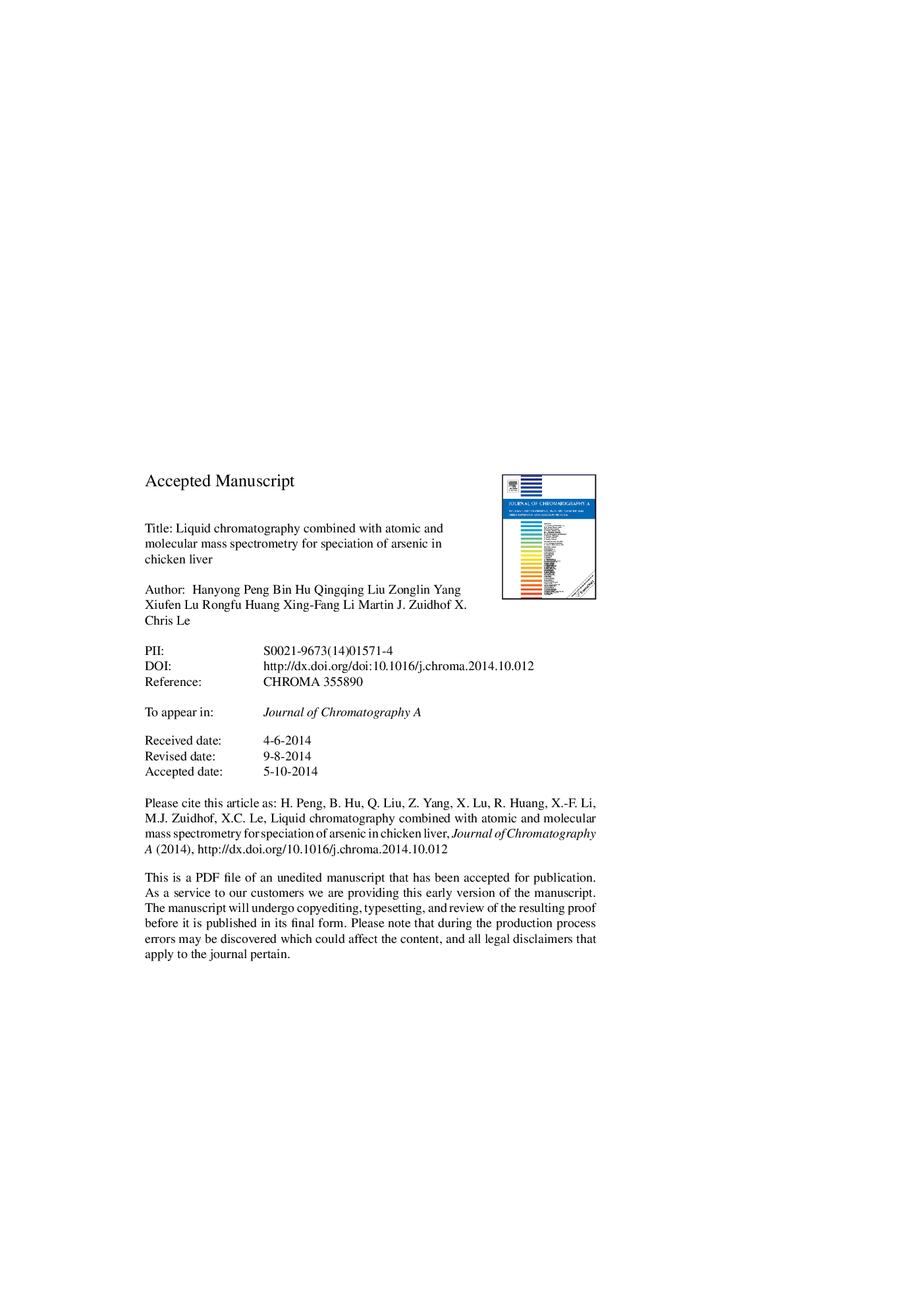| کد مقاله | کد نشریه | سال انتشار | مقاله انگلیسی | نسخه تمام متن |
|---|---|---|---|---|
| 7612357 | 1493556 | 2014 | 37 صفحه PDF | دانلود رایگان |
عنوان انگلیسی مقاله ISI
Liquid chromatography combined with atomic and molecular mass spectrometry for speciation of arsenic in chicken liver
ترجمه فارسی عنوان
کروماتوگرافی مایع همراه با طیف سنجی اتمی و مولکولی برای تعیین آرسنیک در کبد مرغ
دانلود مقاله + سفارش ترجمه
دانلود مقاله ISI انگلیسی
رایگان برای ایرانیان
کلمات کلیدی
شکل گیری آرسنیک، جگر مرغ، کروماتوگرافی مایع طیف سنجی جرمی پلاسما به صورت القایی، طیف سنجی جرم الکترو اسپری، فینیلارسنیکال،
موضوعات مرتبط
مهندسی و علوم پایه
شیمی
شیمی آنالیزی یا شیمی تجزیه
چکیده انگلیسی
Human exposure to high concentrations of arsenic from water and food is an important health concern. Although 3-nitro-4-hydroxyphenylarsonic acid (Roxarsone) was used for more than 60 years as a feed additive to feed chickens, little is known about the metabolism of this arsenic species in chicken. Determination of potential arsenic metabolites present at trace concentrations is an analytical challenge, requiring efficient separation and sensitive detection. The primary objective of this research is to develop a method that enables the identification and quantification of various arsenic species in chicken liver. This report describes a method of high performance liquid chromatography (HPLC) separation with both inductively coupled plasma mass spectrometry (ICPMS) and electrospray ionization tandem mass spectrometry (ESI-MS/MS) detection. Anion exchange HPLC enabled the separation of Roxarsone and other arsenic species within 12Â min. Detection with both ICPMS and ESI-MS/MS allowed for identification and quantification of eight arsenic species in chicken livers, including arsenobetaine, inorganic arsenite, dimethylarsinic acid, monomethylarsonic acid, inorganic arsenate, 3-amino-4-hydroxyphenylarsonic acid, N-acetyl-4-hydroxyphenylarsonic acid (N-AHPAA), and Roxarsone. The concentrations of these arsenic species, with the exception of arsenobetaine, are significantly higher in the Roxarsone-fed chickens than in the control chickens. The simultaneous detection by both ICPMS and ESIMS from the same HPLC separation allowed for comparison of peaks in both ICPMS and ESIMS chromatograms. This is advantageous over two separate analyses, particularly when HPLC retention times might fluctuate due to sample matrix effect. HPLC separation with the complementary atomic and molecular mass spectrometry detection prevented misidentification of co-eluting compounds, as demonstrated by the determination of two possible metabolites of Roxarsone, N-AHPAA and 4-amino-phenylarsonic acid (4-APAA). N-AHPAA was confirmed by HPLC separation with simultaneous arsenic-specific detection by ICPMS and multiple reaction monitoring by ESIMS. Although an arsenic-containing compound had identical retention time as 4-APAA in the HPLC-ICPMS chromatogram, it was ruled out as 4-APAA from the simultaneous detection by ESIMS. The identification and quantitation of trace arsenic species present in complex samples demonstrate the potential of HPLC separation with simultaneous ICPMS and ESIMS detection for other speciation applications.
ناشر
Database: Elsevier - ScienceDirect (ساینس دایرکت)
Journal: Journal of Chromatography A - Volume 1370, 28 November 2014, Pages 40-49
Journal: Journal of Chromatography A - Volume 1370, 28 November 2014, Pages 40-49
نویسندگان
Hanyong Peng, Bin Hu, Qingqing Liu, Zonglin Yang, Xiufen Lu, Rongfu Huang, Xing-Fang Li, Martin J. Zuidhof, X. Chris Le,
